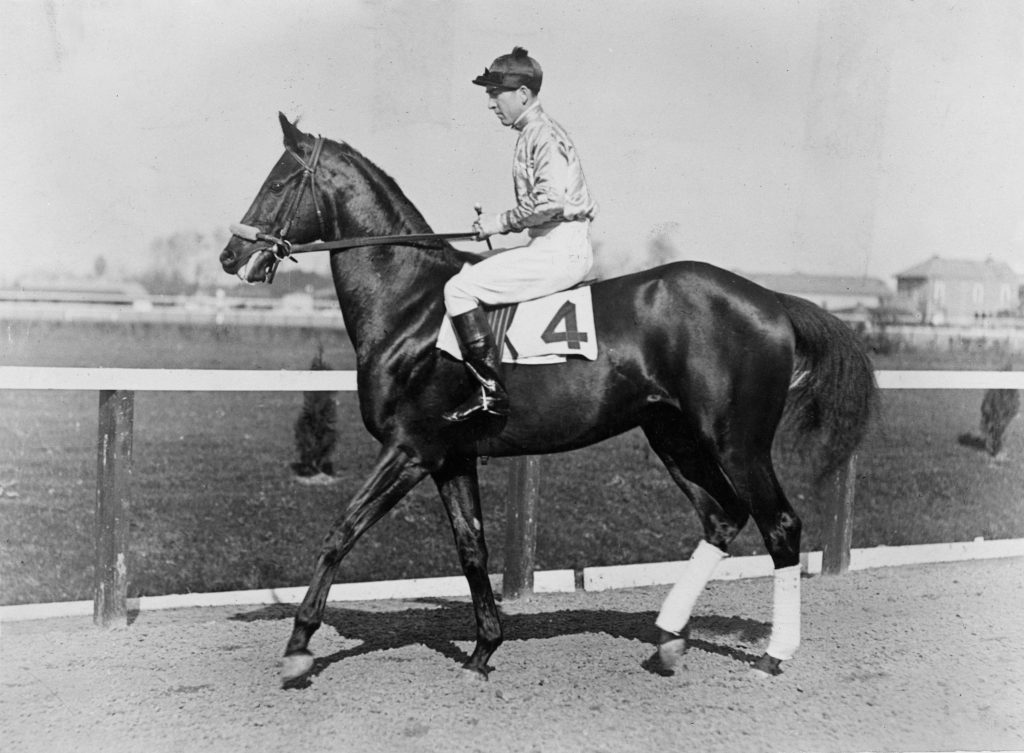
It’s the stuff that movies are made from. A man on his deathbed relays to his Native American wife a vision he has of an as-yet born colt winning the Kentucky Derby. The woman promises him it will happen, and it does.
This is the way Black Gold’s story begins, and it’s mostly legend. But the colt, named for his color and the newly discovered oil in his home state of Oklahoma, overcame great odds to not only get to the 1924 Kentucky Derby, but win it for Mrs. Rosa Hoots.
The story starts in 1909 when Al Hoots bought a 2-year-old mare named USeeIt, trading 80 acres of his own land in Oklahoma for her at a fairgrounds. The mare was small and paunchy but hardy, winning 34 of 122 races over her long seven-year career. She raced mostly short distances at the small western tracks and made enough money for Al and his wife, Rosa, to live on.
In 1916, Al made the mistake of entering her in a claiming race in Juárez, Mexico. She was claimed, but Al, with the threat of a shotgun at his side, refused to turn her over to the new owner and took her back to Oklahoma. Racing officials were outraged and had him and USeeIt banned from all racing in North America.
Al’s health began to decline, and he developed an obsession with the idea of breeding USeeIt to a Kentucky stallion named Black Toney. Black Toney was not very impressive on the racetrack, winning only 13 of 40 starts, but had an impeccable pedigree. His father was the great Peter Pan, his damsire Ben Brush, and the legendary Domino’s blood flowed through his veins as well.
Al, who had some Choctaw ancestry, continued to repeat his wishes to Rosa, who was half Osage and half French. After Al died, oil was discovered on the Hoots’ land, and Rosa had enough money to fulfill Al’s wishes. She sent the small, portly mare to Kentucky to be bred to Black Toney, and the result was a colt that Rosa named Black Gold.
Black Gold won his first race at the Fair Grounds in New Orleans on Jan. 8, 1923. He got a nail stuck in his foot and lost his second race, but after some rest he came back and won nine of 18 races as a 2-year-old.
He continued his success early on in 1924, winning a few allowance races with ease before demolishing a field of Eastern hopefuls in the Louisiana Derby on March 17. He led from wire to wire, sloshing through the slop on a rainy day to win by six lengths. The Kentucky Derby was now a possibility.
Black Gold went east, where he demolished the competition by eight lengths in the Derby Trial on May 13, four days before the Derby was to be run. He was pulled up at the end to preserve his strength.
No worries. He had plenty on Derby Day, which was the golden jubilee of the Kentucky Derby. The 50th running of the race would be seen by some 80,000 people who crammed into Churchill Downs that day. Transmute, Bracadale and Mad Play were the horses to beat, along with Black Gold, the favorite, whose legend was growing with every win.
Rosa Hoots took her seat in the owners’ box— only the second woman owner of a horse in the Derby and the first Native American to sit there. She watched quietly and waited as the horses lined up.
As the barrier came down, Black Gold was slammed into the rail by Bracadale, who went on to take the lead into the first turn. Black Gold, meanwhile, was boxed in by three other horses and had nowhere to go. Jockey John Mooney waited patiently and on going into the far turn, he spotted a narrow gap and urged the colt to squeeze through. Using his mother’s sprinting ability, Black Gold smashed through the opening, setting his sights on Bracadale and two other horses.
As the field entered the final turn, Bracadale still held a two-length lead, but Black Gold and Chilhowee were coming after him. Chilhowee got there first and overtook Bracadale with a furlong to go. Black Gold went wide on the turn, made a dash down the stretch and caught Chilhowee, nudging away for a half-length victory. It was the closest margin of victory of his career.
Mrs. Hoots received $52,775 — the winner’s share of the Derby purse, and for the first time officials gave a large three-and-a-half pound golden cup to the winner. Perhaps distrustful of white men’s promises to her mother’s tribe, she demanded that the prize winnings be given to her immediately in cash.
Black Gold went on to win the Ohio Derby by three lengths and the Chicago Derby by eight, becoming the first horse to win derbies in four different states. Later that year, he developed a quarter crack in his hoof and was retired. But he proved to be infertile, so at the age of 6, he returned to racing, starting four times without a win. He won one dollar for his efforts.
Then came January 18, 1928, when the stallion, then 7, ran in the Salome Purse at the New Orleans Fair Grounds. He was fighting for second in the homestretch when he broke his left foreleg, His jockey tried to pull him up, but Black Gold continued to race valiantly on three legs. He was euthanized at the same track where he had his first race. He was buried in the infield..
In 1989, Black Gold was elected to the National Museum of Racing and Hall of Fame. His record? Eighteen wins in 35 starts, with five seconds and four thirds. His story was so unbelievable Marguerite Henry wrote a book about him, and he got a movie in 1947. And it’s only fitting for a story you could find only at the movies.



